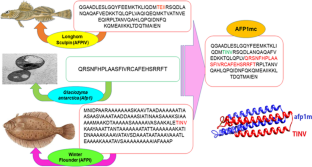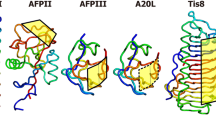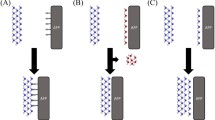Abstract
Antifreeze proteins (AFPs) represent a distinctive class of proteins that exist in organisms thriving in sub-zero conditions and act as an inhibitor of ice growth by binding to the ice interfaces. The melting or growing inhibition characterization can explain the adsorption–inhibition mechanism. This mechanism occurred within the thermal hysteresis activity of AFPs and is not amenable to measure experimentally. AFPIV is a newly discovered type of AFPs that exhibit remarkably low activity in inhibiting ice recrystallization. Herein, the novel mutation of AFPIV has been developed through the incorporation of afp1m peptide fused to the AFPIV’s third helix with a newly designed linker. The bioinformatics tools were employed for verification purposes to evaluate and analyze the model. The main focus of the present study pertains to the ice growth inhibition and Kelvin effect associated with the AFPIV mutant (AFP1mc) in comparison with AFPIV at different temperatures. The investigation revealed that in AFP1mc the rate of ice growth in the surrounding area experiences a significant reduction regarding the ice depression point as dictated by the Gibbs–Thomson effect. Moreover, it can be deduced that above the equilibrium melting point, ice melting is inhibited by the formation of the concave ice/water while, below that temperature, the ice growth inhibition observed through the ice water convex formation; however, this mechanism exhibits greater strength in AFP1mc owing to its superior affinity toward ice interaction. These findings provide evidence that the activity of AFP1mc is much higher than the original AFPIV, rendering it competent for additional experimental investigations and practical deployment in AFP contexts.













Similar content being viewed by others
Data availability
The analysis was exclusively carried out using publicly available data, as specified in the text. Code and the datasets used are made freely available.
References
Aho N, Buslaev P, Jansen A, Bauer P, Groenhof G (2022) Scalable constant pH molecular dynamics in GROMACS. J Chem Theory Comput 18:6148–6160. https://doi.org/10.1021/acs.jctc.2c00516
Alaidarous M (2020) In silico structural homology modeling and characterization of multiple N-Terminal domains of selected bacterial Tcps. Peer J 8:e11043. https://doi.org/10.7717/peerj.10143.eCollection2020
Barrett J (2001) Thermal hysteresis proteins. Int J Biochem Cell Biol 33:105–117. https://doi.org/10.1016/s1357-2725(00)00083-2
Baskaran A, Kaari M, Venugopal G, Manikkam R, Joseph J, Bhaskar P (2021) Antifreeze proteins (Afp) properties, sources and applications. Int J Biol Macromol 189:292–305. https://doi.org/10.1016/j.ijbiomac.2021.08.105
Benkert P, Kunzli M, Schwede T (2009) QMEAN server for protein model quality estimation. Nucleic Acids Res 37:W510–W514. https://doi.org/10.1093/nar/gkp322
Benkert P, Tosatto SCE, Schomburg D (2008) QMEAN: a comprehensive scoring function for model quality assessment. Proteins Struct Funct Bioinform 71:261–277. https://doi.org/10.1002/prot.21715
Berman HM, Westbrook J, Feng Z, Gilliland G, Bhat TN, Weissig H, Shindyalov IN, Bourne PE (2000) The protein data bank. Nucleic Acids Res 28:235–242. https://doi.org/10.1093/nar/28.1.235
Bhattachary M, Hota A, Kar M, Chini DS, Malick RC (2018) In-silico Structural and Functional modeling of Antifreeze protein (AFP) sequences of Ocean pout (Zoarces americanus, Bloch & Schneider 1801). J Genet Eng Biotechnol 16:721–730. https://doi.org/10.1016/j.jgeb.2018.08.004
Bjelkmar P, Larsson P, Cuendet MA, Hess B (2010) Implementation of the CHARMM force field in GROMACS: analysis of protein stability effects from correction maps, virtual interaction sites, and water models. Chem Theory Comput. https://doi.org/10.1021/ct900549r
Combet C, Blanchet C, Geourjon C, Deléage G (2000) NPS@: network protein sequence analysis. Trends Biochem Sci 25:147–150. https://doi.org/10.1016/s0968-0004(99)01540-6
Darden T, York D, Pedersen L (1993) Particle mesh Ewald: an N-log(N) method for Ewald sums in large systems. J Chem Phys 98:10089–10092. https://doi.org/10.1063/1.464397
Davies PL, Baardsnes J, Kuiper MJ, Walker VK (2002) Structure and function of antifreeze proteins. Philos Trans R Soc Lond B 357:927–935. https://doi.org/10.1098/rstb.2002.1081
Deng G, Laursen RA (1998) Isolation and characterization of an antifreeze protein from the longhorn sculpin. Myoxocephalus Octodecimspinosis Biochimica Et Biophysica Acta 1388:305–314. https://doi.org/10.1016/s0167-4838(98)00180-0
DePristo MA, DeBakker PI, Blundell TL (2004) Heterogeneity and inaccuracy in protein structures solved by x-ray. Crystallography J Struc 12:831–838. https://doi.org/10.1016/j.str.2004.02.031
Ebbinghaus S, Meister K, Prigozhin MB, DeVries AL, Havenith M, Dzubiella J, Gruebele M (2012) Functional importance of short-range binding and long-range solvent interactions in helical antifreeze peptides. Biophys J 103(7):L20–L22
Ekpo MD, Xie J, Hu Y, Liu X, Liu F (2022) Antifreeze proteins: Novel applications and navigation towards their clinical application in cryobanking. Int J Mol Sci 23:2639. https://doi.org/10.3390/ijms23052639
Ellis CR, Shen J (2015) pH-dependent population shift regulates BACE1 activity and inhibition. J Am Chem Soc 137:9543–9546. https://doi.org/10.1021/jacs.5b05891
Eskandari A, Leow TC, Rahman MBA, Oslan SN (2020) Antifreeze proteins and their practical utilizations in industry, medicine, and agriculture. Biomol J 10:1649. https://doi.org/10.3390/biom10121649
Fernandez RG, Abascal JLF, Vega C (2006) The melting point of ice ih for common water models calculated from direct coexistence of the solid-liquid interface. J Chem Phys 124:144506. https://doi.org/10.1063/1.2183308
Frenkel D, Smit B (1996) Understanding molecular simulation. Academic Press, San Diego
Gasteiger, E, Hoogland C, Gattiker A, Duvaud S, Wilkins M, Appel A, Bairoch A (2005) Protein identification and analysis tools on the ExPASy server 112: 531–52. https://doi.org/10.1385/1-59259-584-7:531
Gerhauser J, Gauker V (2021) Detailed analysis of the ice surface after binding of an insect antifreeze protein and correlation with Gibbs-Thomson equation. Langmuir 37:11716–11725. https://doi.org/10.1021/acs.langmuir.1c01620
Ghalamara S, Silva S, Brazinha C, Pintado M (2022) Structural diversity of marine anti-freezing proteins, properties and potential applications. Bioresour Bioprocess. https://doi.org/10.1186/s40643-022-00494-7
Gharib G, Saeidiharzand SH, Sadaghian A, Kosar A (2022) Antifreeze proteins: a tale of evolution from origin to energy application. Front Bioeng Biotechnol 9:770588. https://doi.org/10.3389/fbioe.2021.770588
Kelley LA, Mezulis S, Yates CM, Wass MN, Sternberg MJ (2015) The Phyre2 web portal for protein modeling, prediction and analysis. Nat Protoc 10:845–858. https://doi.org/10.1038/nprot.2015.053
Kim HJ, Lee JH, Hur YB (2017) Marine antifreeze protein: structure and application to cryopreservation as a potential cryoprotectant. Mar Drugs 15:27. https://doi.org/10.3390/md15020027
Knight CA, Wierzbicki A (2001) Adsorption of biomolecules to ice and their effects upon ice growth. 2. A discussion of the basic mechanism of “antifreeze” phenomena. Cryst Growth Des 1:439–446. https://doi.org/10.1021/cg015532l
Koyama Y, Tanaka H, Gao G, Zeng XC (2004) Melting points and thermal expansivities of proton-disordered hexagonal ice with several model potentials. J Chem Phys 121:7926. https://doi.org/10.1063/1.1801272
Kristiansen E, Zachariassen KE (2005) The mechanism by which fish antifreeze proteins cause thermal hysteresis. Cryobiology 51:262–280. https://doi.org/10.1016/j.cryobiol.2005.07.007
Kuiper M, Morton CM, Abraham M, Weale A (2015) The biological function of an insect antifreeze protein simulated by molecular dynamics. Struct Biol Mol Biophys 7:4e05142. https://doi.org/10.7554/eLife.05142
Kulieva V, Zamora W, Martinez E, Tirado L (2022) Effect of antifreeze proteins on the freeze-thaw cycle of foods: fundamentals, mechanism of action, current challenges and recommendations for future work. Heliyon 8:e10973. https://doi.org/10.1016/j.heliyon.2022.e10973
Kumari S, Muttachikavil AV, Tiwari JK, PunnathanaM SN (2020) Computational study of differences between antifreeze activity of Type III antifreeze protein from ocean pout and its mutant. Langmuir 36:2439–2448. https://doi.org/10.1021/acs.langmuir.0c00065
Kurniawan J, Ishida T (2022) Protein model quality estimation using molecular dynamics simulation. ACS Omega 7:24274–24281. https://doi.org/10.1021/acsomega.2c01475
Lovell SC, Davis IW, Arendall WB, De Bakker PI et al (2003) Structure validation by C-alpha geometry: phi, psi and C-beta deviation. Proteins J 50:437–450. https://doi.org/10.1002/prot.10286
Lee H (2018) Structures, dynamics, and hydrogen-bond interactions of antifreeze proteins in TIP4P/Ice water and their dependence on force fields. PLoS ONE 13:e0198887. https://doi.org/10.1371/journal.pone.0198887
Maddah M, Shahrabi M, Peyvandi K (2021) How does DcAFP, a plant antifreeze protein, control ice inhibition through the Kelvin effect? Ind Eng Chem Res 60:18230–18242. https://doi.org/10.1021/acs.iecr.1c02559
Madura JD, Wierzbicki A, Harrington JP, Maughon RH, Raymond JA, Sikes CS (1994) Interactions of the D and L forms of winter flounder antifreeze peptide with the 201 planes of ice. J Am Chem Soc 116:417–418. https://doi.org/10.1021/ja00080a066
Marilene SR, Chirle F, Joao G, Edna RA (2019) Effect of the antifreeze protein on microstructure of strawberries. Food Technol 22:9. https://doi.org/10.1590/1981-6723.21818
Melo F, Feytmans E (1998) Assessing protein structures with a non-local atomic interaction energy. J Mol Biol 277:1141–1152. https://doi.org/10.1006/jmbi.1998.1665
Midya US, Bandyopadhyay S (2018) Operation of Kelvin effect in the activities of an antifreeze protein: a molecular dynamics simulation. J Phys Chem B 1:1–31. https://doi.org/10.1021/acs.jpcb.8b00846
Mofiz Uddin Khan NM, Atari T, Tsuda S, Kondo H (2021) Characterization of microbial antifreeze protein with intermediate activity suggests that a bound-water network is essential for hyperactivity. Sci Rep 11:5971. https://doi.org/10.1038/s41598-021-85559-x
Naing A, Kim CH (2019) A brief review of applications of antifreeze proteins in cryopreservation and metabolic genetic engineering. 3 Biotech J 9:329. https://doi.org/10.1007/s13205-019-1861-y
Nguyen H, Le L (2017) Investigation of changes in structure and thermodynamic of spruce budworm antifreeze protein under subfreezing temperature. Sci Rep 7:40032. https://doi.org/10.1038/srep40032
Nguyen H, Le L, Ho TB (2014) Computational study on ice growth inhibition of Antarctic bacterium antifreeze protein using coarse grained simulation. J Chem Phys 140:225101. https://doi.org/10.1063/1.4881895
Pakhrin SC, Sherstha B, Adhikari B, Dukka B (2021) Deep learning-based advances protein structure prediction. Int J Mol Sci 22:5553. https://doi.org/10.3390/ijms22115553
Pal P, Aich R, Chakraborty S, Jana B (2022) Molecular factors of ice growth inhibition for hyperactive and globular antifreeze proteins: insight from molecular dynamics simulation. Langmuir 38:15132–15144. https://doi.org/10.1021/acs.langmuir.2c02149
Pettersen EF, Goddard TD et al (2004) UCSF Chimera—a visualization system for exploratory research and analysis. J Comput Chem 25:1605–1612. https://doi.org/10.1002/jcc.20084
Raymond JA, DeVries AL (1977) Adsorption inhibition as a mechanism of freezing resistance in polar fishes. Proc Natl Acad Sci USA 74:2589–2593. https://doi.org/10.1073/pnas.74.6.2589
Rifai EA, Dijk MN, Vermeulen PE, Yanuar A, Geerke DP (2019) A comparative linear interaction energy and MM/PBSA study on SIRT1–ligand binding free energy calculation. JCIM 59:4018–4033. https://doi.org/10.1021/acs.jcim.9b00609
Robles V, Valcarce DG, Riesco MF (2019) The use of antifreezeproteins in cryopreservation of gametes and embryos. Biomolecules 9:181. https://doi.org/10.3390/biom9050181
Schauperl M, Podewitz M, Ortner T, Waibl F (2017) Balance between hydration enthalpy and entropy is important for ice binding surfaces in antifreeze protein. Scientific Rep 7:11901. https://doi.org/10.1038/s41598-017-11982-8
Schwede T (2003) Swiss-model: an automated protein homology-modeling server. Nucleic Acids Res 31:3381–3385. https://doi.org/10.1093/nar/gkg520
Shah SH, Rajv K, Azren A, Asmavi A et al (2012) Solution structure, Dynamic and ice growth inhibitory activity of peptide fragments Derived from an Antarctic yeast protein. PLoS ONE 7:e49788. https://doi.org/10.1371/journal.pone.0049788
Sheikh M, Tsuda S (2018) Application of antifreeze proteins: practical use of the quality products from Japanese fishes. Adv Exp Med Biol 1081:321–337. https://doi.org/10.1007/978-981-13-1244-1_17
Steinhardt PJ, Nelson DR, Ronchetti M (1983) Bond-orientational order in liquids and glasses. Phys Rev B 28:784–805. https://doi.org/10.1103/PhysRevB.28.784
Suros-Valls R, Votes IK (2019) Peptidic antifreeze materials: prospects and challenges. Int J Mol Sci 20:5149. https://doi.org/10.3390/ijms20205149
Thomson SW (1871) On the equilibrium of vapor at a curved surface of liquid. Phil Mag 4:448–452
Vega C, Sanz E, Abascal JLF (2005) The melting temperature of the most common models of water. J Chem Phys 122:114507. https://doi.org/10.1063/1.1862245
Wang C, Pakhomova S, Newcomer ME, Christner BC, Luo BH (2017) Structural basis of antifreeze protein activity of a bacterial multi-domain antifreeze protein. PLoS ONE 12:1–19. https://doi.org/10.1371/journal.pone.0187169
Wang J, Yoo S, Bai J, Morris JR, Zeng XC (2005) Melting temperature of ice ih calculated from coexisting solid-liquid phases. J Chem Phys 123:36101. https://doi.org/10.1063/1.1950647
Waterhouse A, Bertoni M, Bienert S, Studer G, Tauriello G et al (2018) SWISS-MODEL: homology modelling of protein structures and complexes. Nucleic Acids Res 46:768. https://doi.org/10.1093/nar/gky427
Wathen B, Kuiper M, Walker V, Jia Z (2003) A new model for simulating 3-D crystal growth and its application to the study of antifreeze proteins. J Am Chem Soc 125:729–737. https://doi.org/10.1021/ja0267932
Wen D, Laursen RAA (1992) A model for binding of an antifreeze polypeptide to ice. Biophys J 63:1659–1662. https://doi.org/10.1016/S0006-3495(92)81750-2
Wilson P (1993) Explaining thermal hysteresis by the Kelvin effect. Cryo-Lett 14:31–36
Wu X, Yao F, Zhang H, Li J (2021) Antifreeze proteins and their biomimetic for cell cryopreservation, mechanism, function and application. Int J Biol Macromol 192:1276–1291. https://doi.org/10.1016/j.ijbiomac.2021.09.211
Zandiyeh S, Ebrahimi F, Sabbaghian M (2018) Application of antifreeze protein on sperm cryopreservation. Crimson Publ 1:22–34. https://doi.org/10.31031/PRM.2018.01.000520
Acknowledgements
The authors are thankful to the members of the Enzyme and Microbial Technology Research Center (EMTech) for the constructive comments and help in the completion of this manuscript.
Funding
This project was supported by the Prototype Research Grant Scheme (PRGS) from the Ministry of Higher Education (MoHE) Malaysia PRGS/1/2021/STG02/UPM/02/2 which was awarded to the last author (SNO).
Author information
Authors and Affiliations
Contributions
EA, TCL, MBAR, and SNO wrote original preparation, EA, TLC, MBAR and SNO wrote abstract, prepared tables, and all figures, and EA and SNO edited the manuscript. All authors have reviewed and agreed to the published version of the manuscript.
Corresponding author
Ethics declarations
Conflict of interest
The authors declare no conflict of interest.
Additional information
Publisher's Note
Springer Nature remains neutral with regard to jurisdictional claims in published maps and institutional affiliations.
Rights and permissions
Springer Nature or its licensor (e.g. a society or other partner) holds exclusive rights to this article under a publishing agreement with the author(s) or other rightsholder(s); author self-archiving of the accepted manuscript version of this article is solely governed by the terms of such publishing agreement and applicable law.
About this article
Cite this article
Eskandari, A., Leow, T.C., Rahman, M.B.A. et al. Molecular dynamics-guided insight into the adsorption–inhibition mechanism for controlling ice growth/melt of antifreeze protein type IV mutant from longhorn sculpin fish. Chem. Pap. (2024). https://doi.org/10.1007/s11696-024-03407-4
Received:
Accepted:
Published:
DOI: https://doi.org/10.1007/s11696-024-03407-4




